Nokia Lumia 800 Review
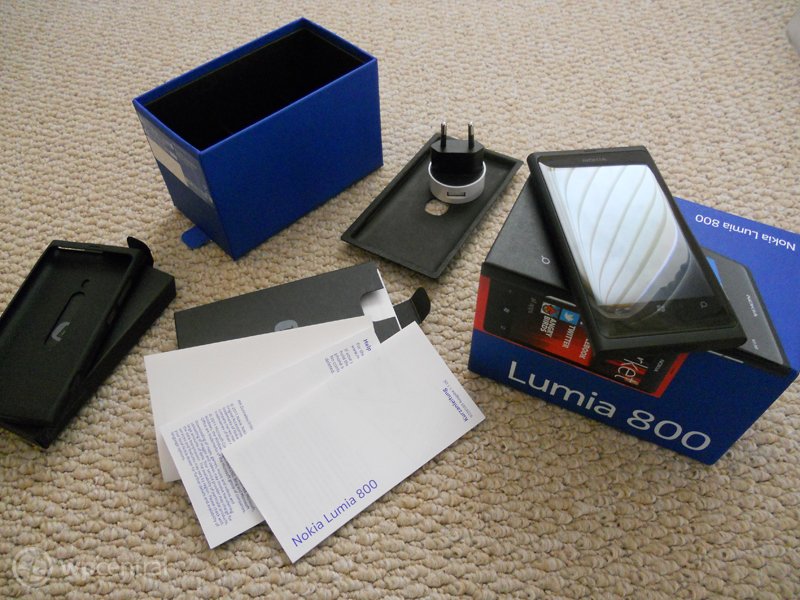
The Nokia Lumia 800 is the final result of hard work and active development in the time that was available since they announced the partnership with Microsoft earlier this year. Nokia has stated that 2012 will be the year to look out for innovative hardware, powerful handsets (with possibly dual-core chips) and much more. The Lumia family also includes the 710, a more affordable option.
The Lumia 800 is a solid phone with a unibody and a single piece of injection-moulded polycarbonate. The Gorilla toughened glass appears to "fold" into the chasis to provide the design a smooth surface. The screen is a ClearBlack AMOLED display, which ensures there's enough attention focused on what's being projected. The technology used in construction allows the Lumia 800 to be used in sun light. Being powered by a 1.4Ghz chip and fuelled by a 1450mAh battery, the Nokia Lumia 800 is a perfect handset for those who are arriving to the platform or looking to upgrade. Head on past the break for the run through.
| Design:The Lumia 800 is designed and manufactured to perfection. This shows in the end result, while there may be a few issues with buttons, it's still a solid design. | Feel:Unibody, check. Single piece of injection moulded polycarbonate, check. Feels great to hold and use? Check. | 9out of 10 |
| Performance:Powered by Windows Phone Mango, a 1.4Ghz processor and a lasting 1450mAh battery, the Lumia 800 will keep you going throughout the day. | Quality:This is Nokia's first attempt at creating a "true" Windows Phone. The result is outstanding with the time the manufacturer had, but there's a long way to go. |
| Nokia has finally released some hardware to rack up sales and boy have they released something special. The Lumia 800 extracts the positives from the N9 and applies some Windows Phone goodness. | Unfortunately, the buttons really do let the overall polished design down, and the capacitive keys are far too close to the screen. |
| Sure, the Lumia 800 could have been so much more with a front-facing camera, more solid buttons and other bits and bobs, but for a first attempt, and within a tight deadline, the handset is a superb Mango device. The design is slick, the feel is smooth and the looks are modern. This simplistic approach to manufacturing fits in nicely with the principles of the Metro UI and the 800 is a worthy upgrade. |
Design & Hardware
The Nokia Lumia 800 features a unibody with curved glass that almost "folds" into the one piece body. Being 61mm x 116mm and 12mm thick, the device itself is thin, easy to handle and feels great when in use. Coming in at 142g, the 800 is fairly light and in line with other handsets. The single piece of injection-moulded polycarbonate ensures antenna performance is at maximum efficiency to prevent signal loss and call drop outs. Although many could be put off by what seems to be a re-introduction of the N9, which runs MeeGo, experiencing what’s packed into this minimalistic design reminds the consumer just how much development has gone into perfecting the end result.
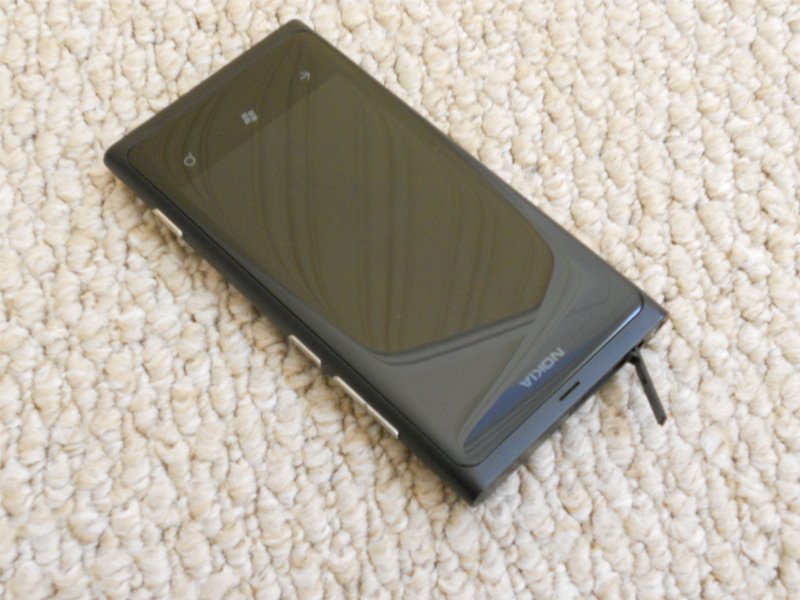
The Lumia 800 sports an 8MP camera with f/2.2 Carl Zeiss lens, another feature brought forward from the N9. The Lumia 800 lacks a front-facing camera.
Powering the device is a single core 1.4Ghz processor (Qualcomm MSM8255), which still proves to be ample amount of power for tasks ran on Windows Phone. The amount of storage available to owners is 16GB, with no SD card slot, but to liven up the mood there’s 512MB worth of RAM and a 1450mAh battery will ensure connectivity and usage can last a fair amount of time.
Unfortunately there are a few annoyances that lie with the Lumia 800, which is all down to the buttons located on the device. The physical buttons on the right-side of the handset are not the sturdiest of buttons found on electronic devices, and the rattling that can be heard when handling the handset doesn’t fit the overall strive of perfection Nokia has taken with the unibody. While we’re attacking the buttons on the Lumia 800, the capacitive keys, that already find themselves in the "hate" list of Windows Phone owners, are far too close to the display. If you thought accidentally pressing the search button was easy, you’ve witnessed nothing yet.
The colour selection brought in by Nokia with the N9 have been carried across - black, cyan and magenta - and pigments run right the way through the polycarbonate body as opposed to simply being applied to the surface. Should you happen to scratch or dent the handset, it will not appear visible to the naked eye due to the colour under the surface blending in with the external. The design is slick and modern, but there are a few hiccups here and there that should have been ironed out.
Get the Windows Central Newsletter
All the latest news, reviews, and guides for Windows and Xbox diehards.
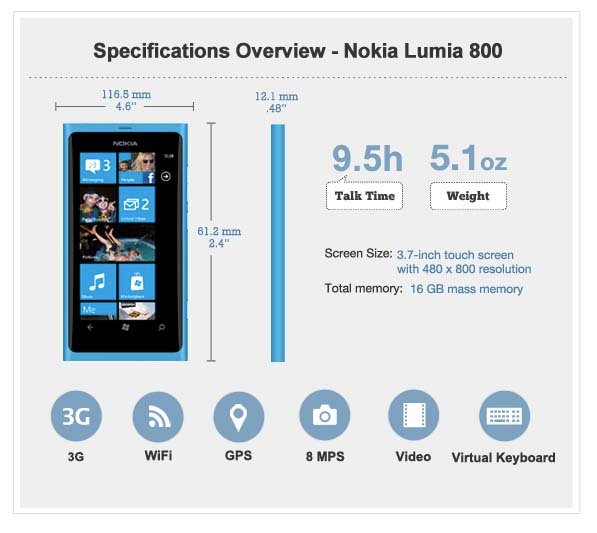
Screen
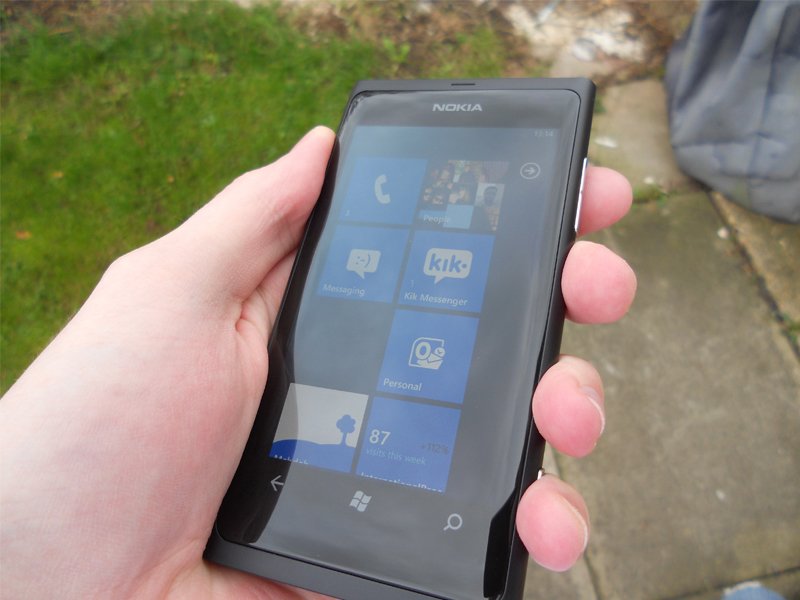
The 3.7" ClearBlack AMOLED screen is the highlight of the Lumia 800 with the curved glass spanning from top-to-bottom. The display is on par with the HTC Titan and Radar, but its hidden trick is allowing usage in the sunshine, something that can’t be achieved with other Windows Phones easily. Helping to create the illusion that the screen is part of the phone is the Nokia’s ClearBlack tech, where blacks appear black and it’s fairly difficult to distinguish where the screen ends. The curved glass also ensures that, when viewing the screen from multiple angles, content shown is crisp and quality is maintained.
Camera
The Nokia Lumia 800 takes the camera from the N9 with an 8MP sensor and f/2.2 Carl Zeiss lens being packed. There’s also dual LED flash present to light up your life when capturing those memorable moments. How does it perform out and about? Check out our quick shots of the Nokia Arch in Stratford, UK. We also put it to the test with the Samsung Omnia 7, which arguably has the best camera out of first generation handsets.

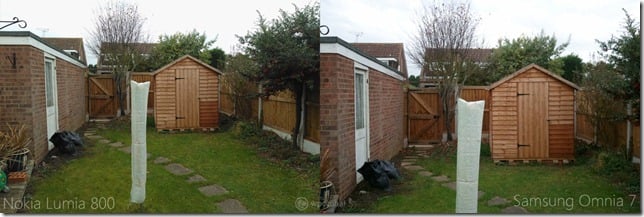
They say images speak louder than words, so we'll leave you to draw your own conclusion from the above comparisons. While performance and quality is solid, it's still no match for a digital or SLR. The 800 will be perfect for capturing any moment with the quick camera wake up function in Windows Phone. As well as capturing photos, 720p video can be recorded along with VGA. Check out our quick test of the 720 capabilities of the Lumia 800 in the below video. Excuse the wind, we don't have the best weather here in the UK.
Software & Apps
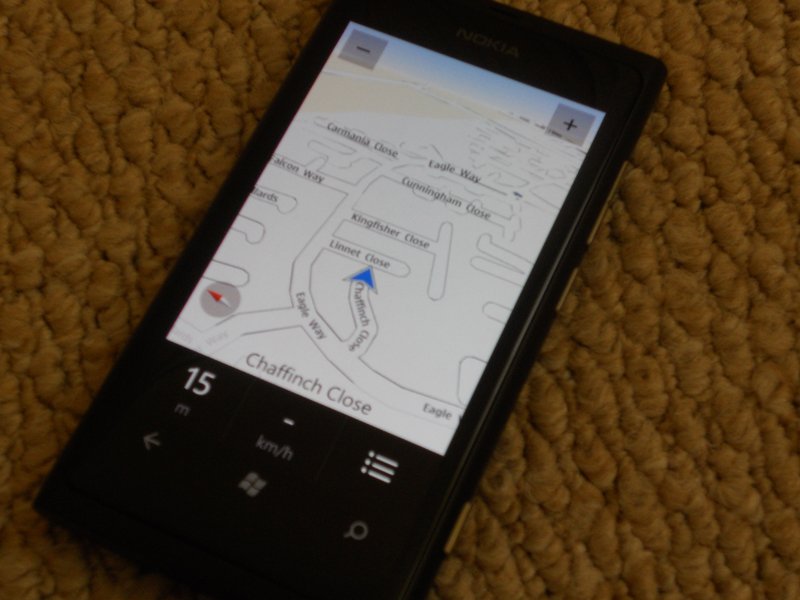
The Lumia 800 comes packed with Windows Phone Mango, the latest version of Microsoft's mobile operating system. As well as the usual vanilla features, which can be read up on with our Mango update coverage, Nokia has installed a handful of apps that are unique to the Lumia family of devices. We've covered these apps previously and links will be provided for further detail.
First up we have App Highlights, which is targeted at Windows Phone users who are not familiar with both the platform and what apps are available on the Marketplace. The app itself focuses on local developers in regions, as well as the "must have" and most popular apps to-date. Next up is Contacts Transfer, an app solely developed with Symbian users in mind. Should you be moving from Nokia's old OS to Windows Phone, Contacts Transfer will enable you to transfer your contacts via Bluetooth, which are then uploaded to the Live ID and stored in the cloud. Neat, eh?
Nokia Drive is Nokia's free GPS turn-by-turn navigation app, which is pre-installed on each and every Lumia handset. The app sports voice guidance and offline maps that can be downloaded prior to starting a journey. Handy if you're thinking on going abroad and would like to avoid high data costs. Nokia Maps, which is to be released to every Windows Phone in the coming weeks, will make finding local points of interest easier.
Finally we have Nokia Music, a free Spotify-like streaming service that enables the user to stream mixes and download them for offline usage. Songs within a mix can be individually purchased from the Marketplace and there's a fair number of genres present to choose from. Local gigs are also displayed with further detail.
Performance
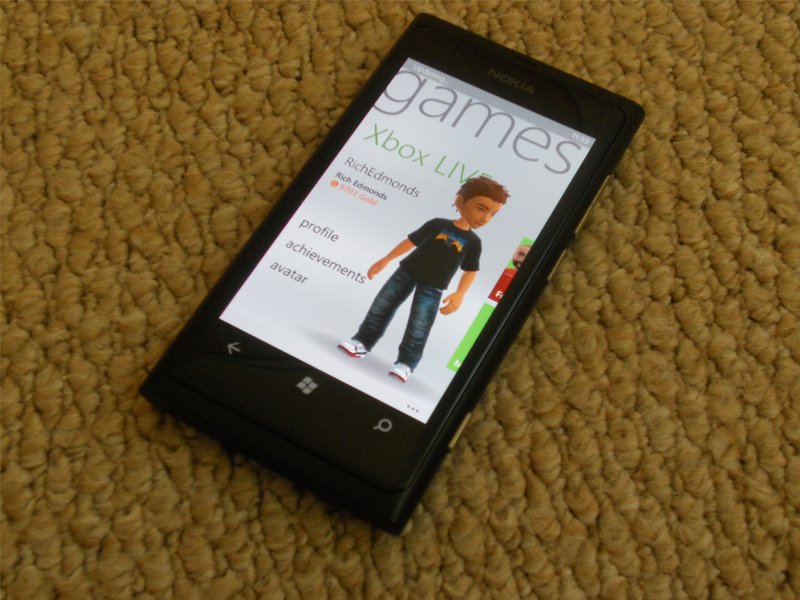
The performance of the Lumia 800 is pretty much standard when it comes to Windows Phone. With the addition of background agents in Mango, email accounts with push enabled and general usage we managed to pull out about 22 hours before we were left in the hands of the battery saver. Although general use will vary from owner to owner, it should be noted that battery life may or may not be longer lasting.
The chip that the handset features is clocked at 1.4Ghz, which will drain the battery through heavy usage, but provides the Lumia 800 with a notable push when launching apps, web browsing and other CPU intensive tasks. The reception and call quality is fairly stable, thanks to the materials used in device construction. Windows Phone Mango runs smoothly on Nokia's first handset, and the hardware compliments the operating system when the screen is active. It should be noted that tethering is currently not supported by the Lumia 800 at present.
Conclusion
Now that you've read our written review of the Nokia Lumia 800, why not check it out visually? The video below is our quick walk through of what the handset offers and how it could change your life after purchase.
A smartphone is used throughout each day and allows millions of people to communicate with one another while on the move. Whether it be my social networking, calling, video conferencing or texting, these devices should be designed and built to be admired. Nokia has hit this nail on the head with the design of the Lumia 800, it makes you look forward to using it, to picking up a call, and playing Xbox Live titles.
As mentioned in the video the 800 will be available in black from November 16th while the magenta will hold you back until the 28th. The handset will cost £399.00 (€420) and comes with a charger, manuals, USB cable, protective case and earphones. Hopefully the U.S. Market will see the Lumia 800 early next year.
Is the Lumia 800 worth the purchase? Yes, especially for new (or potential) consumers, since the handset packs some impressive features and is powered by Windows Phone Mango. The design is slick, the feel is soft and the experience is impressive. Nokia have some way to go to regain control of the market, but the Lumia family of devices is a step in the right direction.

Rich Edmonds was formerly a Senior Editor of PC hardware at Windows Central, covering everything related to PC components and NAS. He's been involved in technology for more than a decade and knows a thing or two about the magic inside a PC chassis. You can follow him on Twitter at @RichEdmonds.
